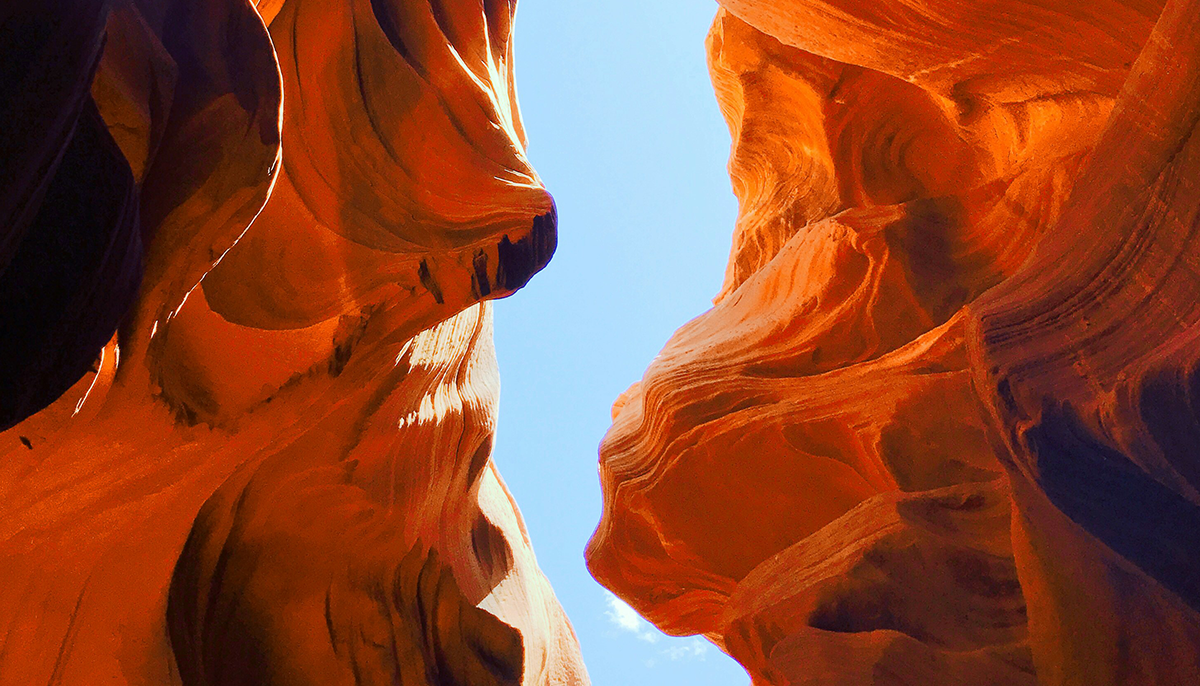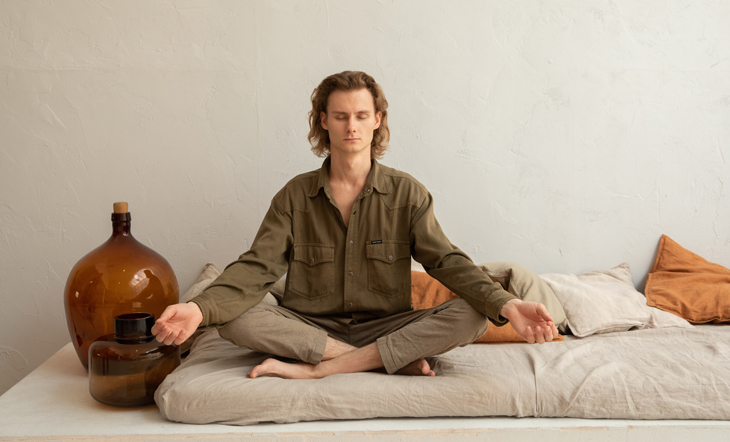Let Your Mind Move
Francis Sanzaro on the profound potential for awakening found in unifying body and mind. The post Let Your Mind Move appeared first on Lion’s Roar.

Two summers ago, my family and I visited Stagecoach Reservoir in the heart of the Colorado Rockies. The wind was blowing out of the west, which meant that, standing at the edge of the dam, on the east rim of the reservoir, we were getting blown over. My kids loved it, relishing in the sensation. As we played, I heard a dull whistling sound. I looked around, but before I could find the source, I got distracted, noticing an old Coke bottle lying in the dust. The glass was thick, scratched, worn — a relic. I pulled it to my face for a closer look, then I heard the whistle again.
I listened, and there it was again. A dull, struggling humm.
For the past few months, I’d been trying to articulate what it was I was feeling around the topics of nature, the body, and Buddhism. Something was nagging at me from within, spinning my internal wheel. I was thinking about it on this day as well.
The humm sounded again. I pulled the bottle to my face. That was it. I angled it into the wind just so, and voila. I had my answer.
In Buddhism, we study the mind, but we must rely on knowledge outside of our mind as well. As the Chinese Zen master Seng-Tsan noted in the 6th century: “To seek Mind with the mind is the greatest of all mistakes.”
In my experience, the most direct way to study the mind is through the body. Intelligence, whether in its logical or intuitive varieties, needs a body. Embodied cognition, a relatively recent field of neuroscience, observes that “states of the body modify states of the mind.” The body is more than a mere receiver and processor of stimuli. Stimuli, such as wind, or a child’s cry, which is what our bodies were designed to receive, is a teacher. Sensation, the felt aspect of stimuli, has Buddha mind. Not paying attention to it has karmic effect.
But what, exactly, does that mean? Is the wild, like the wind, a premium source of sensation for “mastering our senses,” as advised in The Dhammapada?
As a lifelong athlete, I’ve experienced the practical and abstract wisdom of the body in ways I wouldn’t have been privy to otherwise. But it’s also deceived me at times. I thought my body wanted the same thing as I did — accomplishing goals and meeting objectives. I thought we were on the same page. While I was undoubtedly in my body 24/7, feeding it, resting it, loving it, I was no more in my body than a feverishly distracted multi-tasker is in their mind.
“Our body” is a concept like any other, a dependent arising. Stimuli in the form of sights, sounds and smells are picked up by receptors; the energy is turned into an electrical signal (transduction), and, down the line, a sensation is registered in our minds, sometimes conscious, sometimes not. A byproduct of all this is that our brain structures information to represent a unified organism in a place. But, as a study published last year found, it is possible to fragment our sense of body and place simply by stimulating a small region of the brain, what they are poetically calling the aPCu.
The takeaway? We don’t really have bodies. We are an assemblage of parts, a tapestry of skin and cells, propped up — literally — by sinew, tendon, and bone, stitched together by the brain. Body becomes whole at the same point as the “self” arises. But there’s one curious fact to all this — our parts have been adapted and born in response to wild landscapes over hundreds of thousands of years. More than “a body,” we have skin with the ability to detect an object half the size of a human hair and eyes able to see candlelight thirty miles away, among other lovely talents. These are the stimuli reception evolutionary history has bequeathed to us. Nature doesn’t just leverage this fact, our bodies are born of and from the wild — structurally, psychologically, emotionally.
There’s no singular approach that Buddhist thought and practice takes to address the body, but I fear we tend to overlook a fundamental assumption of body-practice: just as the body isn’t one thing, mind is not one thing.
The main attribute of the concept of monkey mind is that it is moving all the time. Unsettled. Fickle. Unreliable. Just as it is of the nature of mind to be still (big mind), it is also in its nature to move and inhabit niches and corners of existence (small mind).
In meditation, many put a premium on immovable (big) mind. But that’s an attachment — moveable mind can be delightful. Moveable mind is sensate mind. Takuan Soho, a 16th-century Zen master, poet and painter, observed: “The mind must be left to itself, utterly free to move about according to its own nature. Not to localize it is the end of spiritual training.”
But where, exactly, does mind go when it moves? Takuan continues, “When the ultimate perfection is attained, the body and limbs perform by themselves what is assigned to them to do with no interference from the mind.”
Takuan doesn’t say no mind, but instead “no interference.” Mind moves in such a way as to become finger-mind, nose-mind, tongue-mind, bottom-of-foot-mind, and so on. Each of these minds has a behavior and intelligence of its own.
When we let our bodies do what they were was designed to do — process stimuli — they become whole. Some modern Buddhist practice has not just made an enemy of stimuli, talking about it in the same breath of distraction, but has often lost sight of the intelligence of the body. This is likely due to the distracting nature of the prominent stimuli of our time made up of screens, pings, and notifications. We don’t necessarily need less of stimuli, but instead a higher quality of it.
The original stimuli of our sense organs was the wild world, so we could consider nature a higher quality source. Higher quality doesn’t mean better in absolute terms, but more expeditious for the task. Skillful means, we could say — for the same reason monks for thousands of years value silence when meditating. Silence is skillful.
The obvious question is: What, exactly, can we learn from the body? But really the question should be: How can the body help us unlearn? Buddhist practice can be considered subtractive rather than additive. The intelligence of the body isn’t leveraged for another intelligence. Rather, it is autotelic, from the Greek: “having an end in itself,” to which I’m reminded of one of my favorite quotes by Shunryu Suzuki Roshi: “We do not exist for the sake of something else.” In other words, all forms of mind exist for their own sake when they are present and awake in their environment. The ear, to hear. Skin, to touch. Ear-mind. Skin-mind.
Birdsong, wind (perhaps in the whistle of a coke bottle), and the sound of water are privileged pathways into our bodies. So are the blue-greens hues of nature. We can receive these stimuli deeper than others and move toward them as an animal to safety. Study after study proves nature is good for our mental health and well-being, but we shouldn’t leverage the wild only to buttress our mental health. To be with the wild can be enough. Body practice trains our senses, breathes life into them, and allows mind to enter them.
When your senses awaken, a strange thing happens — joy appears. This joy is not always born because something is beautiful or harmonious, as our senses were also developed to locate the noxious or detect a predator. Rather, joy can be the proverbial fruit of being awake. “Even when the Tathāgata eats the coarsest food, it tastes better than any celestial ambrosia,” reads the Mahāratnakūta Sutra. When it all turns into ambrosia, it’s miraculous, but also mundane. Basic. Archaic.
That day, on the edge of Stagecoach Reservoir, I unlearned something. A body can go about creating the world, achieving this and that, making music, but it also has the ability to be played, to become a musical instrument. We become the Coke bottle. The music being played might be discordant at first, but in time, as with sitting practice, ambrosia emerges.

Francis Sanzaro PhD is a climber, academic, speaker, and the author of books on philosophy, climbing, athletic theory and comparative religion. His essays, poetry and fiction have appeared in The New York Times, Outside, Huffington Post, Climbing, Adventure Journal, The Baltimore Post Examiner, Continental Philosophy Review, and Vol. 1 Brooklyn, Rock and Ice, among a dozen others. His books include the bestseller Zen of Climbing, The Boulder: A Philosophy for Bouldering; and Society Elsewhere: Why the Gravest Threat to Humanity Will Come From Within. He appeared at TEDx Ascend in Colorado speaking on approaches to risk and our relationship with the natural world. He is currently writing Zen of the Wild: A Philosophy for Nature.

 Astrong
Astrong 































